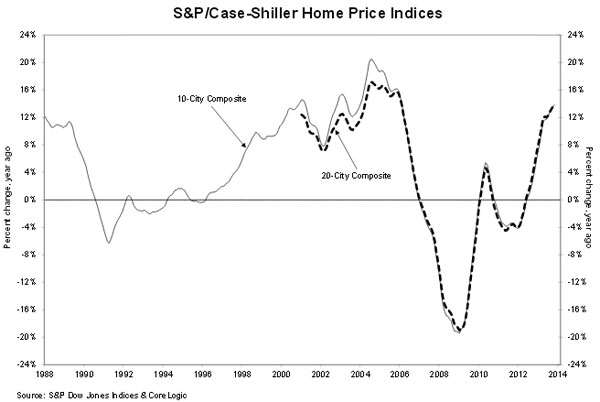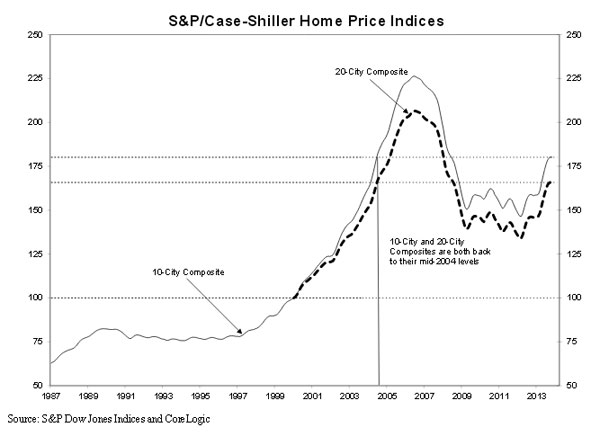The S&P Case-Shiller Composite Indices each posted month-over-month declines in November after nine straight months of growth. The 10-City and 20-City Indices were both down 0.1 percent from October to November but year-over-year the 10-City was up 13.8 percent and the 20-City 13.7 percent.
Monthly results were mixed among the 20 cities with 9 posting increases, nine falling, most only slightly, and two cities, San Diego and Minneapolis, unchanged. Miami had the best showing in November, up 1.2 percent and Las Vegas rose 0.4 percent. Dallas rose only 0.1 percent but still set a new index high. The largest dip was in Chicago, down 1.2 percent while Charlotte fell 0.6 percent.
David M. Blitzer, Chairman of S&P Dow Jones Indices' Index Committee said November was a good month for home prices. "Despite the slight decline, the 10-City and 20-City Composites showed their best November performance since 2004. Prices typically weaken as we move closer to the winter. Las Vegas, Los Angeles, and Phoenix stand out as they have posted 20 or more consecutive monthly gains."

Blitzer said the steady rise in year-over-year price increases began in June 2012 and continued, albeit at a slower pace, in November. "Looking at the year-over-year returns, the Sun Belt continues to push ahead with Atlanta, Las Vegas, Los Angeles, Miami, Phoenix, San Diego, San Francisco, and Tampa taking eight of the top nine spots. Detroit continues to recover but remains the only city with prices below its 2000 level."
The prices increases continue, Blitzer said, despite the jump in mortgage rates last spring. Purchase mortgage applications have been higher in recent weeks, "confirming home builders' optimism shown by the NAHB survey. Combined with low inflation...home owners are enjoying real appreciation and rising equity values." These gains, he said, are likely to slow during the coming year.

Nine metro areas had larger annual returns in November than in October. Boston increased its annual gain from 8.6 percent in October to 9.8; Cleveland and New York were each up 1.1 percentage points to a 6.0 percent annual increase but remain the two lowest ranked among the 20 cities. The other areas where annual gains increased from October to November were Chicago, Dallas, Las Vegas, Miami, Tampa, and Washington.
The strongest annual returns in November were in Las Vegas (+27.3 percent), San Francisco (+23.2 percent), San Diego (18.7 percent) and Atlanta (+18.5 percent.) After New York and Cleveland the smallest increase was in Washington, DC at 7.8 percent.
As of November average home prices across the country were back to levels of mid-2004. Both the 10-and 20-City Composites are now down about 20 percent from their summer 2006 peaks and have recovered by 23.0 percent and 23.7 respectively from post-recession lows reached in March 2012.
The S&P/Case-Shiller Home Price Indices are constructed to track the price path of typical single-family homes in each metropolitan area in the two indices. Each combines matched price pairs of thousands of houses from available arms-length sales data. The indices have a base value of 100 in January 2000 so a current index value of 150 means a typical home has appreciated 50 percent since that date.
Rick Sharga, EVP at Auction.com, shared the following: "Today’s report is indicative of what we’ve been seeing over the last quarter: home price appreciation slowing down, although prices are at much higher levels than they were a year ago.
Much of the increase in home prices in 2013 was due to a rebound in the markets hit hardest during the downturn. And much of that rebound was due to the disappearance of the “foreclosure discount” – distressed properties at the low end of the market were in unusually high demand, often driven by investor activity, and had enormous price increases which skewed the overall numbers a bit. Many of the other published home price indices exclude distressed property sales, and showed lower home price appreciation than Case Shiller.
With less distressed inventory coming to market, and being less discounted when it does come to market, that factor will play much less of a role in 2014 home prices, which suggests that we shouldn’t see nearly as much appreciation this year as we did in 2013."







